Related Research Articles

The Goofy Gophers are animated cartoon characters in Warner Bros.' Looney Tunes and Merrie Melodies series of cartoons. The gophers are small and brown with tan bellies and buck teeth. They both have British accents. Unnamed in the theatrical cartoons, they were given the names Mac and Tosh in the 1960s TV show The Bugs Bunny Show. The names are a pun on the surname "Macintosh". They are characterized by an abnormally high level of politeness.

Cecil Turtle is a fictional character in the Warner Bros. Looney Tunes and Merrie Melodies series of films. Though he made only three theatrical appearances, Cecil has the unusual distinction in that he is one of the very few characters who were able to outsmart Bugs Bunny, and the only one to do so three times in a row and at the rabbit's own game. Cecil often gives Bugs the taunting nickname of "Speedy" when addressing the rabbit.

The Big Snooze is a 1946 Warner Bros. Looney Tunes cartoon directed by Bob Clampett and co-directed by Arthur Davis, who were both uncredited as directors. Its title was inspired by the 1939 book The Big Sleep, and its 1946 film adaptation, also a Warner release. The Big Snooze features Bugs Bunny and Elmer Fudd, voiced by Mel Blanc and Arthur Q. Bryan.
Warner Bros. Cartoons, Inc. was an American animation studio, serving as the in-house animation division of Warner Bros. during the Golden Age of American animation. One of the most successful animation studios in American media history, it was primarily responsible for the Looney Tunes and Merrie Melodies series of animated short films. The characters featured in these cartoons, including Bugs Bunny, Daffy Duck, and Porky Pig, are among the most famous and recognizable characters in the world. Many of the creative staff members at the studio, including directors and animators such as Chuck Jones, Friz Freleng, Robert McKimson, Tex Avery, Robert Clampett, Arthur Davis, and Frank Tashlin, are considered major figures in the art and history of traditional animation.
A Wild Hare is a 1940 American animated comedy short film directed by Tex Avery, produced by Leon Schlesinger, and distributed by Warner Bros. as part of the Merrie Melodies series. The film was released on July 27, 1940, and features Elmer Fudd and Bugs Bunny, the latter making what is considered his first official appearance.
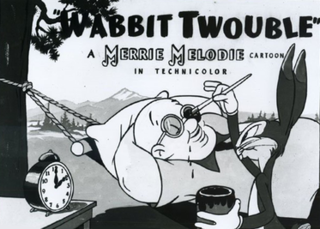
Wabbit Twouble is a Merrie Melodies cartoon starring Bugs Bunny, produced by Leon Schlesinger Productions and released on December 20, 1941, by Warner Bros. Pictures.

The Old Grey Hare is a 1944 Merrie Melodies cartoon directed by Bob Clampett. The short was released on October 28, 1944, and features Bugs Bunny and Elmer Fudd.

The Looney Looney Looney Bugs Bunny Movie is a 1981 American animated comedy package film with a compilation of classic Looney Tunes/Merrie Melodies Warner Bros. cartoon shorts and animated bridging sequences produced and directed by Friz Freleng, hosted by Bugs Bunny. The new footage was produced by Warner Bros. Animation. It was the first Looney Tunes/Merrie Melodies film with a compilation of classic cartoon comedy shorts produced by Warner Bros. Animation.

Hare Force is a 1944 Warner Bros. cartoon in the Merrie Melodies series, directed by Friz Freleng. The cartoon was released on July 22, 1944, and stars Bugs Bunny.
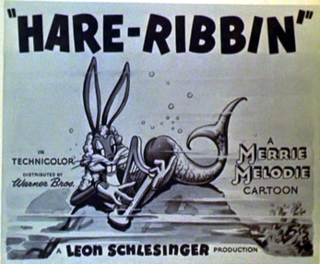
Hare Ribbin' is a 1944 animated short film in the Merrie Melodies series, directed by Robert Clampett and featuring Bugs Bunny. The plot features Bugs' conflict with a red-haired hound dog, whom the rabbit sets out to evade and make a fool of using one-liners, reverse psychology, disguises and other tricks. It was released in theaters by Warner Bros. on June 24, 1944. The title is a pun on "hair ribbon".

Buckaroo Bugs is a 1944 American Western Looney Tunes cartoon film directed by Bob Clampett. The cartoon was released on August 26, 1944, and features Bugs Bunny in his official Looney Tunes debut.
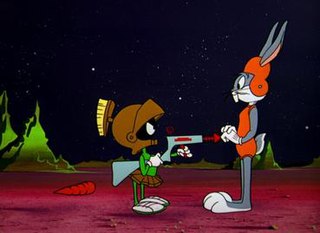
Mad as a Mars Hare is a 1963 Warner Bros. Merrie Melodies cartoon directed by Chuck Jones and Maurice Noble. The short was released on October 19, 1963, and stars Bugs Bunny and Marvin the Martian. The cartoon's title is a play-on-words of the famous phrase to be "mad as a March hare". This is Marvin's final appearance in the Looney Tunes shorts during the Golden Age of American Animation.
This is a list of all cartoons featuring Porky Pig. Directors are listed in parentheses.

Birth of a Notion is a 1947 Warner Bros. Looney Tunes cartoon directed by Bob Clampett and Robert McKimson. The cartoon was released on April 12, 1947, and stars Daffy Duck.
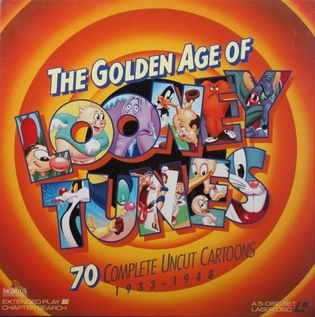
The Golden Age of Looney Tunes is a collection of LaserDiscs released by MGM/UA Home Video in the 1990s. There were five sets made, featuring a number of discs, and each disc side represented a different theme, being made up of seven cartoons per side. The first volume was also released on VHS, with each tape representing one disc side.

Looney Tunes Golden Collection: Volume 5 is a Looney Tunes collection on DVD. Following the pattern of one release each year of the previous volumes, it was released on October 30, 2007.
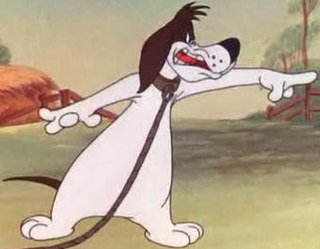
Barnyard Dawg is a Looney Tunes character. A feisty anthropomorphic basset hound, he is a friend and the archenemy of Foghorn Leghorn. He was created by Robert McKimson, who also created Foghorn, and was voiced by Mel Blanc. Dawg also feuds with other enemies as well like Henery Hawk, Daffy Duck and Sylvester. He appeared in 23 Golden Age–era Warner Bros. shorts.
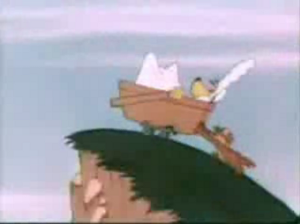
Two Gophers from Texas is a 1948 Warner Bros. Merrie Melodies cartoon directed by Arthur Davis. It was released on January 17, 1948, and features the Goofy Gophers.
References
- ↑ Scott, Keith (2022). Cartoon Voice Of The Golden Age, 1930-70. BearManor Media. p. 68. ISBN 979-8-88771-010-5.
- 1 2 Beck, Jerry; Friedwald, Will (1989). Looney Tunes and Merrie Melodies: A Complete Illustrated Guide to the Warner Bros. Cartoons. Henry Holt and Co. p. 174. ISBN 0-8050-0894-2.
- ↑ Lenburg, Jeff (1999). The Encyclopedia of Animated Cartoons. Checkmark Books. pp. 87–88. ISBN 0-8160-3831-7 . Retrieved 6 June 2020.
- ↑ "Animator Profiles: ARTHUR DAVIS |". cartoonresearch.com. Retrieved 2024-01-09.